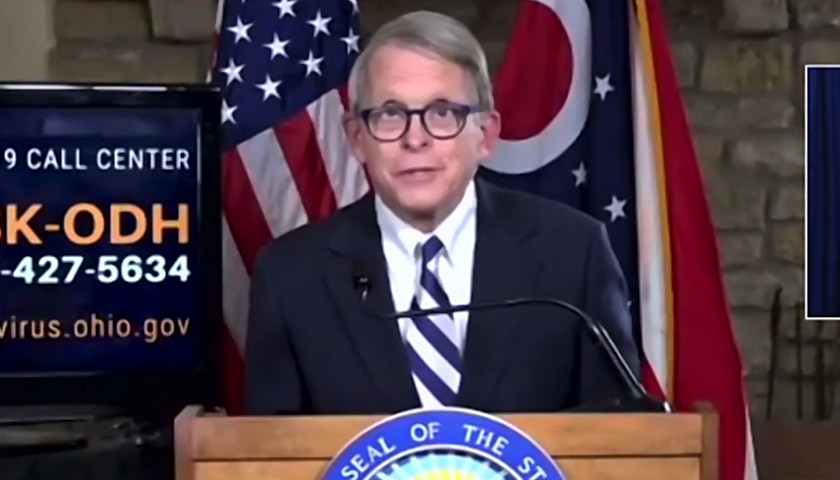by Jennifer Beck
When Governor Mike DeWine announced March 4 that Ohio’s COVID related restrictions would be lifted based on a specific case rate, it didn’t take long to get people talking.
The announcement came on the same day that Connecticut set a date to lift capacity requirements on most businesses and organizations. Two days prior, Texas and Mississippi had announced an ending plan to mask mandates, as well as opening businesses without capacity restrictions. And the Friday after DeWine’s announcement, West Virginia and Arizona declared they are reopening all businesses.
But for Ohio, DeWine had already stated that masks would continue at least through the summer when he took to the airwaves that Thursday to share something new. Some are calling it the “goal post” address, because for the first time, DeWine announced a data goal as the key to reopening Ohio. Others call it the “moving goal post” address, believing DeWine announced a plan that’s impossible to reach.
What is that plan?
If you follow Ohio COVID related news, then by now, you already know about the 50/100000 case goal. When Ohio achieves 50 cases per 100000 residents for a consistent 2 week period, state COVID related restrictions will be relinquished. At the time of this writing, Ohio stood at 161/100000.
The 50/100,000 “goal post” news, not surprisingly, opened a big can of worms on the social media channels. Even before DeWine was done talking Thursday evening, Ohioans were doing their own talking.
“Everyone knows 50/100000 is unreachable as long as we are including antigen tests and probables and having no benchmark level of testing and the PCE cycle threshold…” Said one individual, a person who holds no governmental or medical title, but has done extensive statistical research since the start of the pandemic. (name remaining anonymous per request.)
“If the false positive rate of the tests is only 1%, then we will always have 1000 positive tests per 100000 tests due to the inherent nature of testing.” stated another.
As Ohio’s governor now focuses on a data driven end date; many Ohioans are crunching numbers, analyzing data, and making predictions about if, how and when the 50/10000 number can be achieved.
Two days after DeWine’s dinnertime address, in a social media response to an article published by The Ohio Star, a male follower from the Columbus region stated, “Then they increased PCR testing of asymptomatic patients, especially by doubling testing at colleges and universities…just the false positives will keep us above that threshold.”
The commenter states an accurate fact. Student testing has doubled, effective last week, at Ohio’s largest university.
The same day DeWine announced the “plan to lift restrictions” based on test numbers, The Ohio State University announced the plan to increase testing. “Starting Monday [March 8], on-campus residents will be required to get tested for COVID-19 two times per week…” stated Lantern author, Max Garrison. The article stated that, at that time, the positivity rate for all Ohio State students was 0.68 percent, up from about .4 percent. The on-campus positivity rate standing at 1.02%.
Why the increased testing? According to the University president, it’s due to a double jump in case numbers and a desire to continue to follow public health guidelines. The same week that OSU announced double testing, Cedarville University, in the Ohio governor’s hometown, reported zero cases.
As Cedarville, and other colleges announce low to no cases, Ohio State University launched their increased testing plan March 8. On March 10, they announced a one week pause for all football team activities, due to Monday PCR test results, and the administrative offices at the Woody Hayes Athletic Center are also closed. OSU officials state the decision was made out of an “abundance of caution.”
The decision was made based on results from PCR testing. This is the same testing model that will have an impact on the state reaching Governor DeWine’s 50/100000 opening goal. (OSU Football activities ended up resuming prior to the projected week shut down.)
“Increased PCR cycle reps increases false positive results.” stated an established central Ohio DO, MPH, with an emphasis in epidemiology (who asked to remain anonymous.) Nationwide, critics of many COVID testing systems cite false positives as a red flag indicator of skewed test results.
A September, 2020 study, printed in the Oxford Academic, found that less than 3% of 3790 samples from C-19 cases with PCR tests results over 35 could be cultured into live virus. 97% were false positives, containing only dead fragments.
The PCR test result over 35 is worth noting, because early in the pandemic, results over 40 were counted as positive for the virus. A January 2021 article published in The New York Times, indicates some medical professionals question the threshold accuracy of even the 35 mark.
“In three sets of testing data that include cycle thresholds, compiled by officials in Massachusetts, New York and Nevada, up to 90 percent of people testing positive carried barely any virus, a review by The Times found.” The article referenced Dr. Michael Mina, an epidemiologist at the Harvard T.H. Chan School of Public Health, who stated that “he would set the figure at 30, or even less.” The Times piece also stated that high thresholds weren’t necessarily detecting the live virus, but “leftovers from infection that pose no particular risk…”
So how does this information affect Ohio’s “goal post ending initiative” and what factor could the Ohio State testing have in affecting Ohio’s reopening plan?
To date, there are no established protocols causing testing companies to reveal their threshold. If PCR testing thresholds were published, it would be possible to determine if test results are determined from high or low thresholds. But currently, the public is left to accept the testing result, not knowing what threshold number was used to determine a positive or negative reading. Is Ohio State using a high or low threshold as they are now testing students twice per week? Is it possible that organizations like The Ohio State University temporarily shut down their football program because of false positive numbers? All certainly hope that not to be the case; but with increasing studies questioning the validity of PCR tests, it’s an inquiry worth investigating. We do not want Ohio to remain under restrictions due to false positive testing numbers.
Meanwhile, during his March 8 bi-weekly press conference, a reporter asked Governor DeWine how long he felt it would be until Ohio reached that magic goal number of 50.
“I’m optimistic (cautiously) about where we’re going. How long will that take? I really don’t know. Dr. Vanderhoff and I talk about maybe two months, but I don’t think he knows and I know I don’t know.”
_ _ _
Jennifer Beck is Senior Anchor/Producer and Director of Marketing at WTLW TV-44 in Lima, OH. She writes independently about COVID, health & wellness, medicine, and cancer. Jennifer can be contacted at [email protected].





